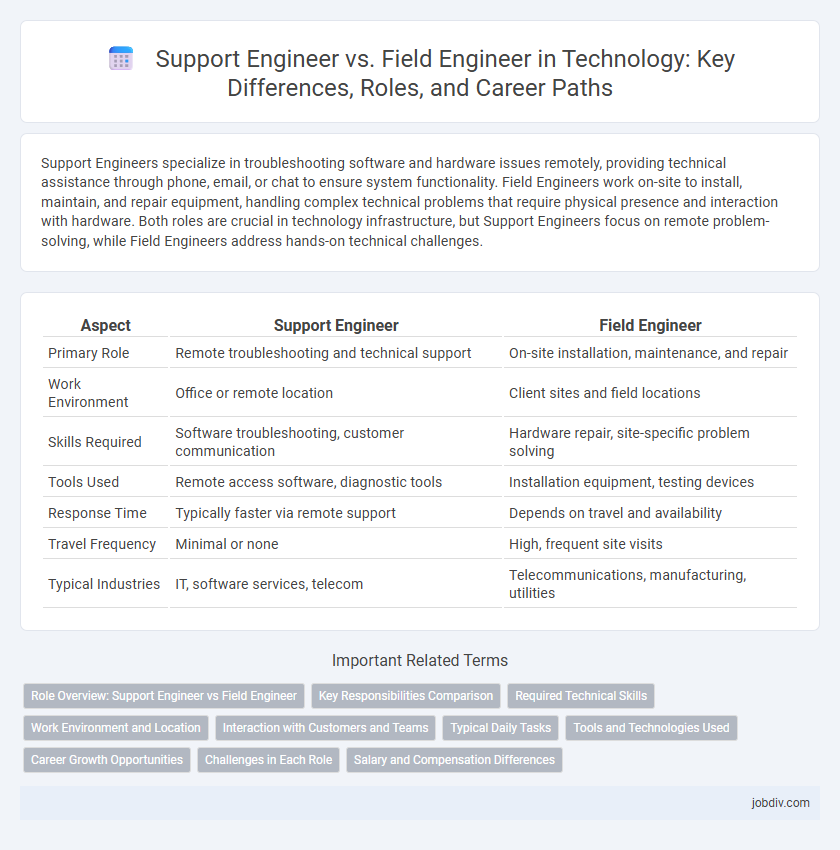Support Engineers specialize in troubleshooting software and hardware issues remotely, providing technical assistance through phone, email, or chat to ensure system functionality. Field Engineers work on-site to install, maintain, and repair equipment, handling complex technical problems that require physical presence and interaction with hardware. Both roles are crucial in technology infrastructure, but Support Engineers focus on remote problem-solving, while Field Engineers address hands-on technical challenges.
Table of Comparison
| Aspect | Support Engineer | Field Engineer |
|---|---|---|
| Primary Role | Remote troubleshooting and technical support | On-site installation, maintenance, and repair |
| Work Environment | Office or remote location | Client sites and field locations |
| Skills Required | Software troubleshooting, customer communication | Hardware repair, site-specific problem solving |
| Tools Used | Remote access software, diagnostic tools | Installation equipment, testing devices |
| Response Time | Typically faster via remote support | Depends on travel and availability |
| Travel Frequency | Minimal or none | High, frequent site visits |
| Typical Industries | IT, software services, telecom | Telecommunications, manufacturing, utilities |
Role Overview: Support Engineer vs Field Engineer
Support Engineers specialize in remote troubleshooting, software issue resolution, and customer assistance through helpdesk systems, ensuring continuous product functionality. Field Engineers focus on on-site installation, maintenance, and repair of hardware infrastructure, often working directly at client locations to implement technical solutions. Both roles require strong technical expertise, but Support Engineers emphasize software support while Field Engineers handle physical equipment and hands-on problem-solving.
Key Responsibilities Comparison
Support Engineers primarily handle troubleshooting software and hardware issues remotely, providing technical assistance through ticketing systems, and maintaining system performance via updates and patches. Field Engineers focus on on-site installations, repairs, and maintenance of physical hardware, ensuring infrastructure integrity and performing network diagnostics in real-time environments. Both roles require strong problem-solving skills, but Support Engineers emphasize remote issue resolution while Field Engineers specialize in hands-on technical support at client locations.
Required Technical Skills
Support Engineers require strong proficiency in remote troubleshooting, software diagnostics, and network protocols, ensuring efficient issue resolution via helpdesk tools. Field Engineers possess hands-on expertise in hardware installation, system configuration, and on-site repair, often needing knowledge of physical infrastructure and safety standards. Both roles demand a solid understanding of operating systems, but Field Engineers require additional skills in logistics and customer interaction during in-person technical support.
Work Environment and Location
Support engineers primarily operate in office settings or remotely, utilizing digital tools to troubleshoot technical issues and assist clients from centralized locations. Field engineers work on-site at client locations or in various outdoor environments, handling equipment installation, maintenance, and repairs that require physical presence. The contrasting work environments demand varying levels of mobility, with support engineers relying on virtual communication and field engineers engaging directly with hardware and infrastructure.
Interaction with Customers and Teams
Support Engineers primarily engage with customers through remote communication channels such as phone, email, and chat to troubleshoot software or hardware issues, ensuring timely resolution and customer satisfaction. Field Engineers work on-site, directly interacting with customers to install, maintain, and repair equipment, providing hands-on technical support and real-time solutions. Both roles coordinate closely with internal teams, but Support Engineers often liaise with development and support teams remotely, while Field Engineers collaborate on-site with technical and service personnel to address complex challenges.
Typical Daily Tasks
Support Engineers primarily handle remote troubleshooting, resolving software and hardware issues via helpdesk systems and providing technical assistance through phone or chat. Field Engineers perform on-site repairs, installations, and maintenance, ensuring physical hardware functionality and network setups at client locations. Both roles require strong problem-solving skills but differ in their focus on remote support versus hands-on, in-person service delivery.
Tools and Technologies Used
Support Engineers primarily utilize remote diagnostic tools, ticketing systems like Jira, and knowledge bases such as Confluence to troubleshoot and resolve software and hardware issues efficiently. Field Engineers rely heavily on portable diagnostic devices, network analyzers, and specialized hardware tools, coupled with mobile access to enterprise resource planning (ERP) systems to perform on-site installations, maintenance, and repairs. Both roles require proficiency in operating systems, scripting languages like Python or PowerShell, and collaboration platforms like Slack or Microsoft Teams to enhance communication and problem resolution workflows.
Career Growth Opportunities
Support Engineers excel in diagnosing and resolving technical issues remotely, gaining expertise in software troubleshooting and customer interaction, which can lead to roles in technical support management or systems engineering. Field Engineers develop hands-on experience with hardware installation, maintenance, and onsite troubleshooting, opening pathways to project management or specialized engineering positions. Both careers offer distinct growth opportunities, with Support Engineers often advancing into technical consultancy or product support roles, while Field Engineers may progress towards field operations management or engineering leadership.
Challenges in Each Role
Support Engineers face challenges in diagnosing complex software issues remotely, requiring deep technical knowledge and effective communication skills to assist diverse clients swiftly. Field Engineers encounter difficulties with on-site troubleshooting in unpredictable environments, managing hardware installations, and ensuring minimal downtime under pressure. Both roles demand adaptability, problem-solving expertise, and continuous learning to keep pace with rapid technological advancements.
Salary and Compensation Differences
Support Engineers typically earn an average salary ranging from $60,000 to $85,000 annually, reflecting their role in remote troubleshooting and customer assistance. Field Engineers command higher compensation, often between $70,000 and $100,000, due to their on-site responsibilities and travel requirements. Variations in salary depend on industry, experience level, and geographic location, with Field Engineers generally benefiting from additional allowances such as travel reimbursements and overtime pay.
Support Engineer vs Field Engineer Infographic

 jobdiv.com
jobdiv.com